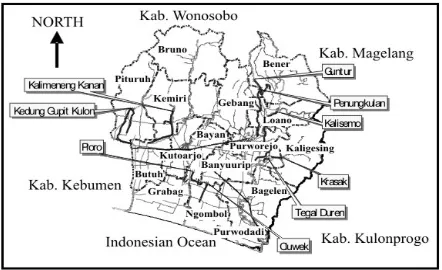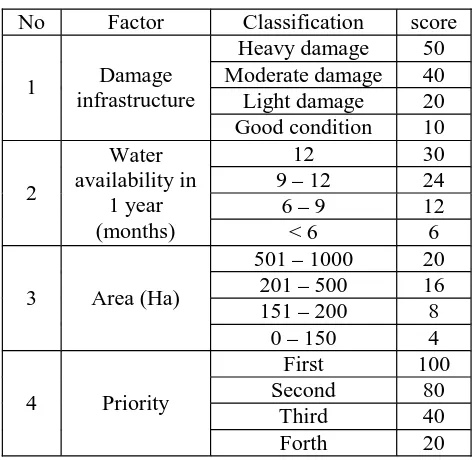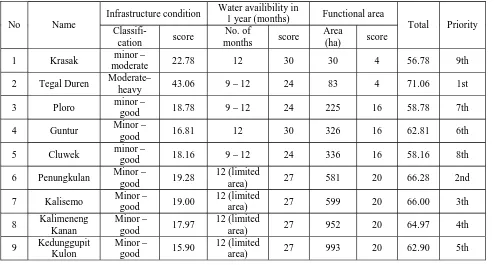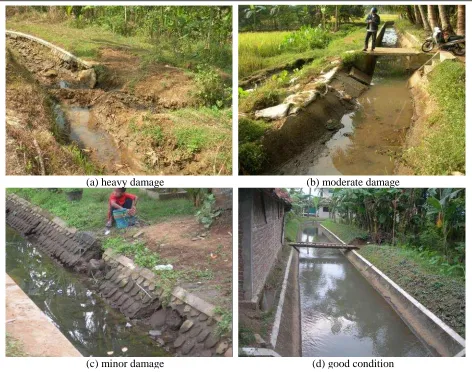ANALYSIS OF REHABILITATION PRIORITY OF IRRIGATION INFRASTRUCTURE
Fatchan Nurrochmad
Senior lecturer, Civil and Environmental Engineering Department, Faculty of Engineering Gadjah Mada University, Jl. Grafika 2 Yogyakarta 55281.
E-mail: fatchan_nurr@yahoo.com
ABSTRACT
The decreasing service function of the technical irrigation system should be supported by routine and periodical maintenance and rehabilitation which needs human resource and costs. Since limited resource is a problem to the government, an analysis of rehabilitation priority is required for 9 irrigation area in Kabupaten Purworejo. Rehabilitation priority analysis to the technical irrigation system taken in this study was carried out by assessing the irrigation water service function, water availability, and functional area. The service function assessment was based on the totally disturbed criteria, semi disturbed criteria, or not disturbed criteria. Results of the analysis showed that the first priority was for increasing the irrigation system status from semi technical to technical irrigation. The first priority was Tegalduren (small and semi technical irrigation) and the last was Krasak (small and technical irrigation). The next priority was large, medium and average irrigation system. Such condition implied that rehabilitation for small (technical) irrigation area was organized by the farmers themselves.
Keywords: technical irrigation system, service function, water availability
INTRODUCTION
In general, irrigation network system in Indonesia, especially in Java, is inherited from Dutch Colonial period. During the period, the system was meant to fulfill water demand for sugar cane cultivated area. This can be indicated by many sugar plant estates remained, some of them are still operating until now (Nurdiyanto, 1994). The purpose of the sugar plants was to utilize the plentiful water resources, land and human resources in Java. This made Indonesia to become the largest sugar exporter after Cuba in the early 20th Century (Sastrodihardjo, 1996).
Water resources (river water) was taken by weirs and flown to paddy fields using technical irrigation network. Up to now, the colonially technical irrigation network systems are about a century old with many of them being well functioned. It proves that the infrastructure operation is in accordance to the procedures. However, routine and periodical maintenance is necessary. It is also proved that rehabilitation without financing obstacle has guaranteed the continuing service function of the irrigation system. The system has been through part
or even total rehabilitation in 80’s and 90’s. The
technical irrigation networks in Kabupaten Purworejo (most of them were Dutch Colonial heritages) are utilized for irrigating paddy and palawija fields. Some of the command areas, covering less than 1000 ha, are currently under the management of Dinas Pengairan Kabupaten Purworejo. In the autonomy era, a problem to be
coped with is that maintenance and rehabilitation costs have not been achieved the needs to have continuing function of the irrigation network system. A study on the operational and maintenance condition is required to identify the performance of the irrigation network system in order to be used for composing the rehabilitation program.
RESEARCH METHOD
Research Location
This research was taken on Dinas Pengairan Kabupaten Purworejo service area. Nine selected command areas were spread evenly in Kabupaten Purworejo, as presented in Figure 1.
The selection was based on the area of the service irrigation network, starting from the smallest (30 ha) to the largest (993 ha). Detailed names, areas, and classifications of each command areas are presented in Table 1.
Data Collecting
Kabupaten Purworejo based on the total score of the irrigation infrastructure damage, water availibilty in a year and command area.
Method of Rapid Appraisal
Rehabilitation priority can be carried out by performing rapid appraisal to several factors. Ministry of Public Works (Ministry of Public Works, 2006) has issued regulations related to the rehabilitation programs, based on the infrastructures condition, water availability, irrigation area,
increasing crop intensity, increasing production and proposed expenditure.
This research assessed the rehabilitation priority by modifying the 6 factors mentioned above into 3 factors. The modification was aimed to simplify on field assessment based on rapid appraisal to three important, stabile and dynamic factors, which were the network infrastructure condition (scoring 10 to 50), water availability (scoring 6 to 30) and irrigation area (scoring 4 to 20, see Table 2).
Figure 1. The locations of the nine command areas
Table 1. Name, area and classification of each command area
No Name Area (ha) Classification
1 Krasak 30 Small, semi technical irrigation
2 Tegalduren 83 Small, technical irrigation
3 Ploro 225 Average, technical irrigation
4 Cluwek 336 Average, technical irrigation
5 Guntur 396 Average, technical irrigation
6 Penungkulan 581 Medium, technical irrigation
7 Kalisemo 599 Medium, technical irrigation
8 Kalimeneng Kanan 952 Big, technical irrigation 9 Kedunggupit Kulon 993 Big, technical irrigation
However, such rapid appraisal faced several obstacles on field. Assessing the irrigation network infrastructures should be classified into several components and scored. The network infrastructures within the technical irrigation, such as weirs, channels, division structures, embankment and
subsequently followed by channel for flowing function, other structures for divisioning and distributing function based on the demands. Detailed scoring to damage infrastructures is shown on Table 4, 5, 6, 7 and 8. Total damage classification of infrastructure of irrigation system can be seen on Table 9.
REHABILITATION OF THE IRIGATION INFRASTRUCTURE
The management of an irrigation network system is an integrated and synchronized operational and maintenance activity. Maintenance is an activity assuring the service function and irrigation water to flowing properly to the paddy field blocks based on the necessities within the technical irrigation network. The objective is to support the operational service in continually providing irrigation water. It consists of continual preservation, reparation, prevention and securing assets of the irrigation network. To prevent decreasing service function, either partial or total rehabilitation is necessary. Pusposutardjo (1996) suggested extending water management by farmers not only to tertiary but also to secondary and even to primary blocks. This indicates that the operational and maintenance activities, including rehabilitation, are under the responsibility of both farmers and governments.
Bappenas (2000) stated that irrigation network rehabilitation was financed by APBN projects and has generated significant amount of liability but without solving the actual problem. Nurbaya (2002) explained that during 20 years, the national expenditures for irrigation infrastructures were significant assets and consequently resulted in significant management expenditures, including the
rehabilitation costs. The farmers’ dependency to the
center government was somehow negative and inconsistence to the revitalization of the irrigation management policy (PKPI).
The decision support system of rehabilitation for all irrigation area in Indonesia has not been either well structured or based on priority scale. It is a burden to solely one particular institution. Such condition is considerably different to decision support system of operation, which is based on crop pattern and schedule composed and agreed by various related institution, including the farmers as the subject. Bruns (2000) stated that rehabilitation required incidental investment. Financing rehabilitation sometimes entails significant amount of fund which often exceeds the kabupaten
government and the farmers’ financial capability.
Financing the rehabilitation should be budgeted within APBN and APBD in Bappeda. Such financing can be assigned based on the request of the farmers request to kabupaten government or from kabupaten government to central government based on the priority assessment (Bappenas, 2000).
Table 2. Classifications of rehabilitation assessment
No Factor Classification score Heavy damage 50 Moderate damage 40 Light damage 20 1 Damage
infrastructure
Good condition 10
12 30
9– 12 24 6– 9 12 2
Water availability in
1 year
(months) < 6 6 501– 1000 20
201– 500 16 151– 200 8 3 Area (Ha)
0– 150 4 First 100 Second 80
Third 40 4 Priority
Table 3. Classifications of the infrastructure scoring
Heavy damage Moderate damage Minor damage Good condition No
(1)
Infrastructure
(2)
% (3)
Score (4)
% (5)
score (6)
% (7)
score (8)
% (9)
score (10) 1 Weir 50.00 25.00 37.50 20.00 18.75 10.00 12.50 5.00 2 Channel 20.00 10.00 15.00 8.00 7.50 4.00 5.00 2.00 3 Division structure 10.00 5.00 7.50 4.00 3.75 2.00 2.50 1.00 4 EIR 15.00 7.50 11.25 6.00 5.63 3.00 3.75 1.50 5 DMS 5.00 2.50 3.75 2.00 1.88 1.00 1.25 0.50 Total score 100.00 50.00 75.00 40.00 37.50 20.00 25.00 10.00
Table 4. Classifications of weirs damages Weight Weir
% Score
Weir body 50 25.00
Intake 20 10.00
Stilling basin 10 5.00
Downstream side 5 2.50
Upstream side 5 2.50
Gates 5 2.50
Intake gate 5 2.50
100 50.00 Total (see Table 3,
column 4, row no.1) 50%*50=25
Table 5. Classifications of channel damages Weight Channel (earth/lined)
% Score
Landslide 25 5.00
Foundation 25 5.00
Sedimentation 25 5.00
Covered by grass 25 5.00
100 20.00 Total (see Table 3,
column 4, row no.2) 20%*50=10
Table 6. Classifications of division structure damages
Weight Division structure
% Score
Main structure 50 5.00
Foundation 20 2.00
Stilling basin 10 1.00
Downstream side 5 0.50
Upstream side 5 0.50
Gates 10 1.00
100 10.00 Total (see Table 3,
column 4, row no.3) 10%*50=5
Table 7. Classifications of embankment and inspection road damages
Weight Embankment and inspection road
% Score
Inspection road 10 1.50
Inside embankment 50 7.50 Outside embankment 40 6.00 100 15.00 Total (see Table 3,
column 4, row no.4) 15%*50=7.5
Table 8. Classifications of discharge measurement structure damages
Weight Structure
% Score
Crest 50 2.50
Discharge / depth board 20 1.00
Screw 10 0.50
Screw steer 5 0.25
Gate 5 0.25
Frame 5 0.25
Peilschaal 5 0.25
100 5.00 Total (see Table 3,
column 4, row no.5) 5%*50=2.5
Table 9. Damage classifications
No Score Damage classification
1 50 Heavy
2 45– 50 heavy– moderate 3 40– 45 moderate– heavy
4 40 Moderate
5 30– 40 moderate– minor 6 20– 30 Minor– moderate
7 20 Minor
8 15– 20 Minor– good 9 10– 15 Good– minor
RESULTS AND DISCUSSION
Total damaged irrigation infrastructure was based on the assessment to weirs, channels, division structures, embankment and inspection road, and discharge measurement structures. Damaged condition was scored based on Table 4 to 8 and classified according to Table 9. Examples of severe damage (total disfunction to irrigating), average damage (part of irrigation water cannot flow through the channels), minor damage (normal irrigation
function but with some damages) and no damage with excellent flowing function are presented in Figure 2.
Based on rapid appraisal to the irrigation network infrastructure on field condition, by observing the flowing function of totally disturbed, partially disturbed, and undisturbed flow and also based on the assessment criteria for each structure (see Table 4 to 8), Then, the results can be seen on Table 10, with total score on Table 11.
Table 10. Results of rapid appraisal to the conditions of irrigation network infrastructure
Table 11. Results of the analysis in rehabilitation priority
Infrastructure condition Water availibility in
1 year (months) Functional area
No Name
Classifi-cation score
No. of
months score
Area
(ha) score
Total Priority
1 Krasak minor–
moderate 22.78 12 30 30 4 56.78 9th
2 Tegal Duren Moderate–
heavy 43.06 9– 12 24 83 4 71.06 1st
3 Ploro minor–
good 18.78 9– 12 24 225 16 58.78 7th
4 Guntur Minor–
good 16.81 12 30 326 16 62.81 6th
5 Cluwek minor–
good 18.16 9– 12 24 336 16 58.16 8th
6 Penungkulan Minor–
good 19.28
12 (limited
area) 27 581 20 66.28 2nd
7 Kalisemo Minor–
good 19.00
12 (limited
area) 27 599 20 66.00 3th
8 Kalimeneng Kanan
Minor–
good 17.97
12 (limited
area) 27 952 20 64.97 4th
9 Kedunggupit Kulon
Minor–
good 15.90
12 (limited
area) 27 993 20 62.90 5th
Name of
infrastructure Guntur
Penung-kulan
Kali-semo Krasak
Tegal
Duren Ploro Cluwek
Kali-meneng
Kanan
Kedung-gupit Kulon
Weir 6.3 6.3 6.3 12.8 24.1 6.9 6.3 6.3 6.3
Channel 5.0 7.5 6.3 3.1 6.9 4.4 5.0 5.6 4.4
Bangunan 1.8 1.6 1.6 2.4 3.8 2.7 2.8 1.6 1.6
Embankment &
inspection road 3.0 3.2 4.1 2.1 5.8 3.8 3.0 3.8 2.8
Device 0.8 0.7 0.8 2.4 2.5 1.1 1.1 0.7 0.8
Figure 2. The channel damage condition.
Small Command Areas
Krasak and Tegalduren are small command areas with different service classification. Krasak command area is served by technical irrigation, and Tegalduren is served by semi technical irrigation system. Technical and semi technical irrigation system management for small areas (less than 100
ha) has been handed over to the water users’
association (WUA), including the operational and maintenance responsibility, as well as rehabilitation.
The farmers’ helplessness, especially in
rehabilitating, has caused infrastructure damage especially for the weir. Results of rapid appraisal showed that the first rank was Tegalduren command area (43.06%) with Krasak at the second (22.78%). These indicate that farmers in Tegalduren command area were helpless in rehabilitating the irrigation network. Such condition was resulted from significant amount of cost to repair the simple weir structure, which was damaged by flood event. As much as Rp. 1,000,000 Irrigation Service Fee (ISF) provided by the farmers will never be enough for
rehabilitation project. The score variation in water availability factor between Krasak and Tegalduren was 6 (see Table 10) and because Tegalduren was situated on Krasak downstream. Scores for area factors are the same (score 4 on Table 10). The total scores for Tegalduren and Krasak are 71.06% and 56.78%, respectively. These scores showed that Tegalduren has more priority than Krasak. The total score of the nine command areas resulted in Tegalduren as the first priority and Krasak for the ninth (last) priority. Programs to transfer small command areas (less than 100 ha) has been carried out by Kabupaten Purworejo Government since 1992. As a small command area, Tegalduren has not been a technical irrigation system and required to be improved to technical before being handed over to WUA. Revitalization to irrigation management policy (PKPI), including rehabilitation, has not been appropriately accomplished. This is because the right
for main network management is the government’s.
WUA has the right for management and utilization only at tertiary level, indicating there has not been (a) heavy damage (b) moderate damage
Nurbaya (2002) also stated that operational and maintenance were often disregarded in cost allocation. It is necessary to more activating the irrigation service fee (ISF) by WUA in order to continue the rehabilitation activities by means of simultaneous financing from the Kabupaten Government of Purworejo .
Average, Medium and Large Command Area
Guntur, Ploro and Cluwek were average command areas with technical service classification. Kalisemo and Penungkulan were medium, both Kalimeneng Kanan and Kedunggupit Kulon were large command areas. All medium and large command areas were technical. Average command area with similar structure and channel length variations comprised damage classification that ranged from 16% to 19%. Such damage conditions in average command areas were lower than those in medium command areas, which ranged between 19% to 20%. It indicated that maintenance in average command areas was better than in medium command areas. Maintenance in large and medium command areas were in balance and received the same attention from the Kabupaten Government of Purworejo.
Water availability in medium and large command areas was significantly better than the average command areas. Such condition was supported with water supply into large and medium command areas from Wadaslintang Dam. More water availability assurance in providing irrigation service would be paid more attention than command areas without water availability throughout the year. Rapid appraisal indicated that water availability in medium command areas was much better than in average command areas. This influenced the final results of the rapid appraisal. Medium and large command areas with water availability throughout the year would be given more rehabilitation priority than medium command areas without water availability throughout the year. Total and final results of the appraisal described that rehabilitation priority would rank from large, medium to average command areas. The three types of command areas were technical. The rehabilitation carried out by the Kabupaten Government of Purworejo was based on the priority scale. The purpose of simultaneous irrigation water fulfillment would be achieved if adequate attention from the Kabupaten Government of Purworejo , especially in rehabilitation projects, is given by allocating the project into APBD. Empowering the WUA should be taken by the government especially in planning the rehabilitation of irrigation infrastructure based on priority scale. Rehabilitation of the irrigation infrastructure is essential and needs to be comprehended by the
decision makers (bureaucrat, DPRD, Non Government Organization) to avoid it being neglected and particular investment being cut (Nurbaya, 2002).
CONCLUSION
The analysis results of rehabilitation priority on the nine command areas in Kabupaten Purworejo can be detailed below.
1. Rehabilitation to semi technical command area, including small command area, is necessary to be done by the government. Irrigation management transfer (PPI) for small command areas is suggested for technical the ones.
2. As a semi technical irrigation system, Tegalduren needs to be improved to technical by rehabilitating the simple weir to become technical weir and positioned in first priority. 3. Rehabilitating the irrigation infrastructure, as the
responsibility for Kabupaten Purworejo Government, was based on the priority scale. The priority scale started from large command areas (Kedunggupit Kulon and Kalimeneng Kanan), and then followed by medium command areas (Kalisemo and Penungkulan) and average command areas (Cluwek, Guntur and Ploro). 4. It is necessary for the decision makers to
understand and not to neglect the routine maintenance.
ACKNOWLEDGMENT
The researcher would like to appreciate and be grateful for Kabupaten Government of Purworejo, especially Dinas Pengairan for the financial support, opportunity and research location. To Ariesto ST, Joko Samiyono ST and Novan, the researcher would like to thank for their assistance in data collecting and analysis.
REFERENCES
Bappenas, 2000, Konsep Konsisten dan Transparan dalam Pembaharuan Kebijakan Pengelolaan Irigasi, Prosiding Lokakarya Pembaharuan Kebijakan Pengelolaan Irigasi, 7-10 Maret 2000, Yogyakarta, p.2.
Bruns, B, 2000, Embracing Water Sector policy Reform in Indoneisa : A Concept for irrigation, Prosiding Lokakarya Pembaharuan Kebijakan Pengelolaan Irigasi, 7-10 Maret 2000, Yogyakarta, p.7.
Petunjuk Teknis Penggunaan Dana Alokasi Khusus Bidang Infrastruktur Tahun 2007. Nurbaya, S., 2002, Otonomi dan Demokrasi Dalam
Pengelolaan Irigasi Di Daerah, Rapat Kerja Pembaharuan Kebijakan Pengelolaan Irigasi, 13 Agustus 2002, Jakarta, p.21.
Nurdiyanto, 1994, Pabrik Gula Madukismo Dalam Lintas Sejarah : Study Awal Tentang Industri Gula (1959 – 1980), Laporan Penelitian Jarahnitra, Balai Kajian Sejarah Dan Nilai Tradisional Yogyakarta.
Pusposutardjo, S., 1996, Perbaikan Managemen Irigasi Untuk Mendukung Usahatani Agroindustri Berkelanjutan, Rancangbangun dan Manajemen Irigasi untuk Mendukung Sistem Usaha Tani Rakyat Yang Berorientasi Agribisnis dan Agroindustri, 2 – 4 Juli 1996, FTP UGM, Yogyakarta, p.61.




